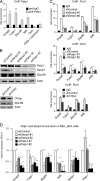Five friends of methylated chromatin target of protein-arginine-methyltransferase[prmt]-1 (chtop), a complex linking arginine methylation to desumoylation
- PMID: 22872859
- PMCID: PMC3494204
- DOI: 10.1074/mcp.M112.017194
Five friends of methylated chromatin target of protein-arginine-methyltransferase[prmt]-1 (chtop), a complex linking arginine methylation to desumoylation
Abstract
Chromatin target of Prmt1 (Chtop) is a vertebrate-specific chromatin-bound protein that plays an important role in transcriptional regulation. As its mechanism of action remains unclear, we identified Chtop-interacting proteins using a biotinylation-proteomics approach. Here we describe the identification and initial characterization of Five Friends of Methylated Chtop (5FMC). 5FMC is a nuclear complex that can only be recruited by Chtop when the latter is arginine-methylated by Prmt1. It consists of the co-activator Pelp1, the Sumo-specific protease Senp3, Wdr18, Tex10, and Las1L. Pelp1 functions as the core of 5FMC, as the other components become unstable in the absence of Pelp1. We show that recruitment of 5FMC to Zbp-89, a zinc-finger transcription factor, affects its sumoylation status and transactivation potential. Collectively, our data provide a mechanistic link between arginine methylation and (de)sumoylation in the control of transcriptional activity.
Figures







Similar articles
-
Modulating the expression of Chtop, a versatile regulator of gene-specific transcription and mRNA export.RNA Biol. 2018;15(7):849-855. doi: 10.1080/15476286.2018.1465795. Epub 2018 May 11. RNA Biol. 2018. PMID: 29683372 Free PMC article. Review.
-
Type I and II PRMTs inversely regulate post-transcriptional intron detention through Sm and CHTOP methylation.Elife. 2022 Jan 5;11:e72867. doi: 10.7554/eLife.72867. Elife. 2022. PMID: 34984976 Free PMC article.
-
PELP1 oncogenic functions involve CARM1 regulation.Carcinogenesis. 2013 Jul;34(7):1468-75. doi: 10.1093/carcin/bgt091. Epub 2013 Mar 13. Carcinogenesis. 2013. PMID: 23486015 Free PMC article.
-
A role for CARM1-mediated histone H3 arginine methylation in protecting histone acetylation by releasing corepressors from chromatin.PLoS One. 2012;7(6):e34692. doi: 10.1371/journal.pone.0034692. Epub 2012 Jun 18. PLoS One. 2012. PMID: 22723830 Free PMC article.
-
SUMO routes ribosome maturation.Nucleus. 2011 Nov-Dec;2(6):527-32. doi: 10.4161/nucl.2.6.17604. Epub 2011 Nov 1. Nucleus. 2011. PMID: 22064470 Review.
Cited by
-
Modulating the expression of Chtop, a versatile regulator of gene-specific transcription and mRNA export.RNA Biol. 2018;15(7):849-855. doi: 10.1080/15476286.2018.1465795. Epub 2018 May 11. RNA Biol. 2018. PMID: 29683372 Free PMC article. Review.
-
Polycomb group RING finger proteins 3/5 activate transcription via an interaction with the pluripotency factor Tex10 in embryonic stem cells.J Biol Chem. 2017 Dec 29;292(52):21527-21537. doi: 10.1074/jbc.M117.804054. Epub 2017 Oct 20. J Biol Chem. 2017. PMID: 29054931 Free PMC article.
-
Molecular insights into the overall architecture of human rixosome.Nat Commun. 2025 Apr 7;16(1):3288. doi: 10.1038/s41467-025-58732-3. Nat Commun. 2025. PMID: 40195365 Free PMC article.
-
Tex10 Coordinates Epigenetic Control of Super-Enhancer Activity in Pluripotency and Reprogramming.Cell Stem Cell. 2015 Jun 4;16(6):653-68. doi: 10.1016/j.stem.2015.04.001. Epub 2015 Apr 30. Cell Stem Cell. 2015. PMID: 25936917 Free PMC article.
-
Flightless-I governs cell fate by recruiting the SUMO isopeptidase SENP3 to distinct HOX genes.Epigenetics Chromatin. 2017 Mar 23;10:15. doi: 10.1186/s13072-017-0122-8. eCollection 2017. Epigenetics Chromatin. 2017. PMID: 28344658 Free PMC article.
References
-
- O'Brien K. B., Alberich-Jordà M., Yadav N., Kocher O., Diruscio A., Ebralidze A., Levantini E., Sng N. J., Bhasin M., Caron T., Kim D., Steidl U., Huang G., Halmos B., Rodig S. J., Bedford M. T., Tenen D. G., Kobayashi S. (2010) CARM1 is required for proper control of proliferation and differentiation of pulmonary epithelial cells. Development 137, 2147–2156 - PMC - PubMed
-
- Zhao X., Jankovic V., Gural A., Huang G., Pardanani A., Menendez S., Zhang J., Dunne R., Xiao A., Erdjument-Bromage H., Allis C. D., Tempst P., Nimer S. D. (2008) Methylation of RUNX1 by PRMT1 abrogates SIN3A binding and potentiates its transcriptional activity. Genes Dev. 22, 640–653 - PMC - PubMed
Publication types
MeSH terms
Substances
Grants and funding
LinkOut - more resources
Full Text Sources
Molecular Biology Databases
Research Materials
Miscellaneous

